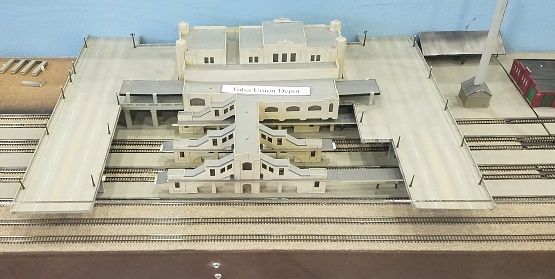Frisco Freight and Union Depot
| Diorama: | Downtown Tulsa -- includes Tulsa Interlocking, Depot and Railway Express |
| Owner Name: | NEONS |
| Sponsor: | Fearless Leader |
| Date Built: | 2008 |
| Date Updated: | 2016 |
| Status: | Active |
| Module Type: | 8' standard module, w/non-standard track position on one end |
| Length: | 8' |
| Width: | 2' |
| Skyboard: | 12" laminate |

Track
| Code | Brand | Turnouts | Crossovers | Passing Sidings | Yard Tracks | Industrial Spurs | Other Tracks |
|---|---|---|---|---|---|---|---|
| 80 | Atlas | various Peco | Yes | four blue line tracks, two yellow line tracks | Yes | Yes | Yes |
Electrical
| Wire | Connector | 110V | |
|---|---|---|---|
| Red | 12 gauge | PP-30 | |
| Yellow | 12 gauge | PP-30 | |
| Blue | 12 gauge | PP-30 | |
| Other | Yes |
| DCC Equipment: | none |
| Powered Accessories: | none |
| Designer | Carpentry | Track | Wiring | Scenery | Oklahoma Scene | Route 66 Scene | Prototype RR |
|---|---|---|---|---|---|---|---|
| Fearless Leader & Pert | Rambo | Pyro & Pert | Pyro | Fearless Leader |

|

|
Track Plan

|
Sign Board
| Frisco Freight House -- Some of the freight shipped on railroads came in lots that were too small to fill a standard 40' box car on their own. These lots were loaded and unloaded at the railroad's freight station. In Tulsa, the St. Louis & San Francisco (Frisco) Railroad's freight station/office was at Elgin Street just east of the Tulsa Union Depot. It handled all of the smaller lots shipped in and out of Tulsa via the Frisco. Most of this building has been razed, but a small portion of the original edifice is still standing. Tulsa Union Depot -- The Tulsa Union Depot was built in 1931 by a consortium of three railroads that would use the depot, the Frisco, MKT, and Santa Fe. The design fits the PWA Moderne style of Art Deco and its theme is derived from Native American art, which is common around Tulsa. Note that the Depot is actually two buildings, a larger facility on the right and a smaller one on the left. In the 1930's the South was still segregated and so-called "Separate but Equal" Jim Crow facilities were the norm. The right side of the depot was for whites and the left side was for people of color. Today the concourse and stairs leading out and down to the tracks are gone and so are the associated platforms and awnings. The main depot building has been renovated and now houses the Oklahoma Jazz Hall of Fame. Bridges & Underpasses -- During the Great Depression, work crews lowered the Frisco tracks from Cincinnati to Cheyenne and the WPA built five north-south bridges over the tracks and an underpass beneath the tracks at Denver Ave to ease traffic blockages due to heavy railroad traffic. |
Description & History
| The NEONS (North East Oklahoma N-Scalers) nearly finished with a multi-year project to rebuild, update and authenticate our twenty-year-old diorama depicting the railroad tracks running across the north side of downtown Tulsa, Oklahoma. Part of the original diorama was featured in the May/June 2003 issue of N-Scale Railroading Magazine. The re-work project was to transfer five 4'modules to three 8' modules, adding a 4' portion that was omitted before. New features are the Denver Street underpass and the de-compression of some tracks into the formerly missing 4' stretch. By modifying these modules from 4'ers to 8'ers, we eliminated a large number of connector tracks which has resulted in easier setup and smoother running. This 3-year project was completed in stages, with the track work, wiring and ballasting completed first, then the buildings were transferred to the new modules with some being rebuilt to better match their prototype, and finally, the remaining scenery was completed. This historically accurate, 24' diorama depicts the north side of downtown Tulsa, Oklahoma circa 1957. Included on the modules from left to right (East to West) are the Tulsa interlocking where tracks from four railroads all crossed and inter-connected, the Frisco Freight building, the 1930's art deco Tulsa Union Depot with the Main Street overpass, the Railway Express Agency facilities, and the Denver underpass. You are looking south and downtown Tulsa sky-scrapers like the National Bank of Tulsa and Philtower (the office building Waite Phillips of Phillips 66 Oil Company gave to the Boy Scouts of America) would be just behind the skyboard of these modules. Old photographs from the archives of the Tulsa World and Tulsa Tribune (the local morning and afternoon newspapers) were utilized along with numerous photos from private files to determine how the north side of downtown Tulsa appeared during this time frame. Sanborn maps and old documents from the Frisco railroad archives provided details on track geometry. |